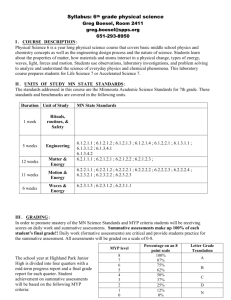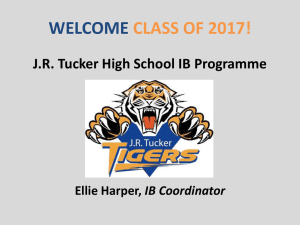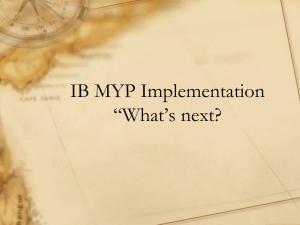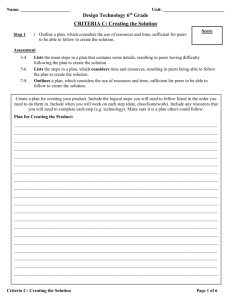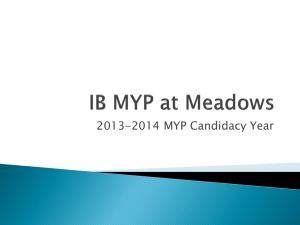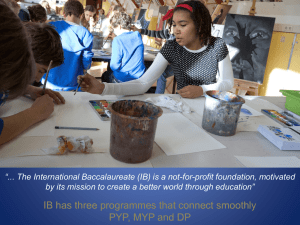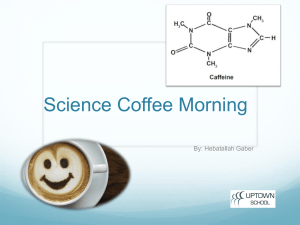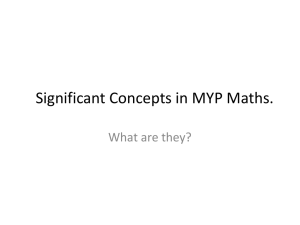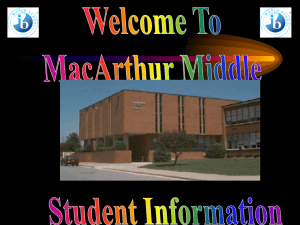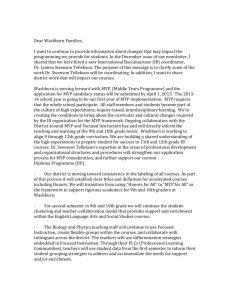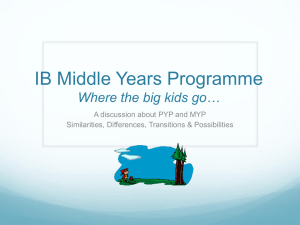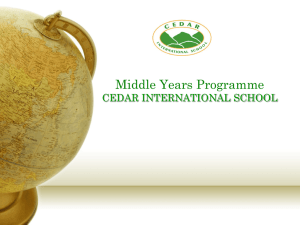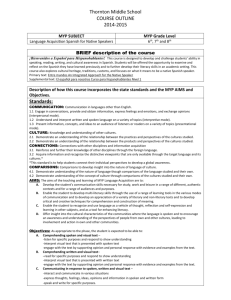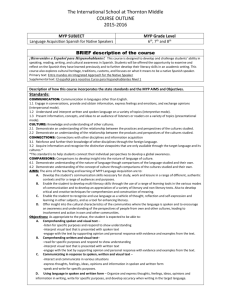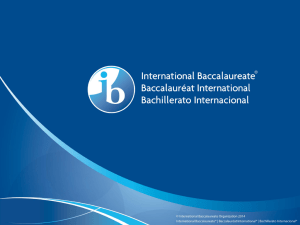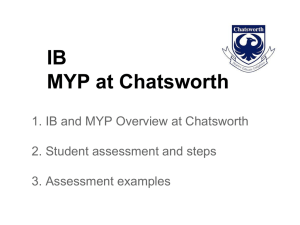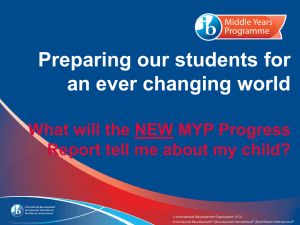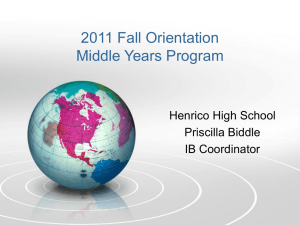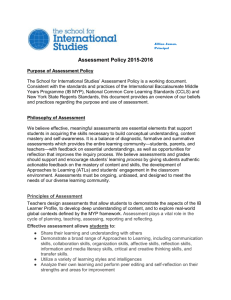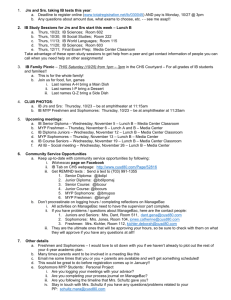MYP Assessment - The International School of the Stockholm Region
advertisement
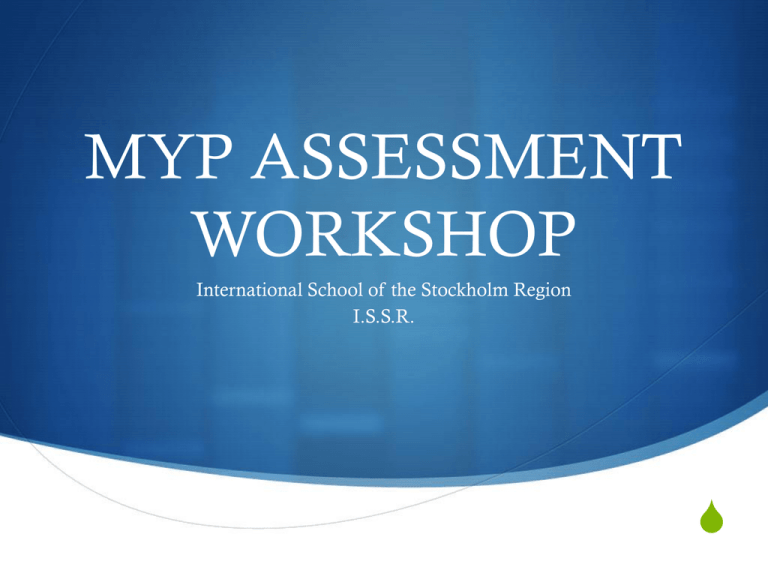
MYP ASSESSMENT WORKSHOP International School of the Stockholm Region I.S.S.R. S Why do we assess students? S To gather information that allows ISSR staff to make informed decisions that affect student learning S To provide reflection for students upon completion of a task according to an assignment and a rubric S To create a road-map for both the teacher and student that allows for goal-setting and sustainable progress and growth in all subjects What is an ISSR MYP Rubric? S A set of evaluation criteria set-forth from the objectives of each subject that identify and measure the growth of a student’s knowledge and skills S A criterion-based assessment that clarifies the goals of every summative assignment and the evaluation standards. S A holistic assessment that allows students to be aware of the criteria against which they are being assessed with clear markers of expected achievement CRITERION-BASED ASSESSMENT S Allows for identification of where a student is and where they need to go (mapping, planning, reflecting). S A consistent approach enables students to make connections across tasks and subjects that then connect to the IB Learner Profile and Approaches to Learning (ATL) S Students SEE what they could/should do BEFORE they start a task! Managebac HOLISTIC ASSESSMENT S Students are compared to themselves, NOT other people S Students are not being put into rank-order file S Encourages more of a range of assessment activities within subjects and across interdisciplinary units that give students more chances to prove how successful they can be. S Everyone has the opportunity to succeed! MYP ASSESSMENT PHILOSOPHY S Informed decision-making that maps student and teacher progress S Use of clear objectives that are attainable and measurable S Criterion-based S Holistic in nature S Open to everyone Subject Criteria and grade boundaries S ALL subjects in the MYP have 4 criteria S A: B: C: D: S The names of these A-D criteria vary according to subject S Each criteria is based on a scale from 0-8 Subject Criteria and grade boundaries Mathematics Science A – Knowing and understanding A – Knowing and understanding B – Investigating patterns B – Inquiring and designing C – Communicating C – Processing and evaluating D – Applying mathematics in real-life contexts D – Reflecting on the impacts of science Subject Criteria and grade boundaries Design Arts A – Inquiring and analysing A – Knowing and Understanding B – Developing ideas B – Developing Skills C – Creating the solution C – Thinking Creatively D - Evaluating D – Responding Subject Criteria and grade boundaries Physical and Health Education Individuals and Societies A – Knowing and understanding A – Knowing and Understanding B – Planning for performance B – Investigating C – Applying and performing C – Communicating D – Reflecting and improving performance D – Thinking Critically Subject Criteria and grade boundaries Language and Literature Language Acquisition A – Analysing A – Comprehending spoken and visual text B – Organizing B – Comprehending written and visual text C – Producing Text C – Communicating in response to spoken, D – Using language written and visual text D – Using language in spoken and written form IB Final Grade Boundaries 1 2 0–5 3 4 5 6 7 6–9 10–14 15–18 19–23 24–27 28–32 For each subject, a student receives a school-year grade based on the scale above General grade descriptors S Grade 1 – Minimal achievement in terms of objectives. S Grade 2 – Very limited achievement against all objectives. The student has difficulty in understanding required knowledge and skills and is unable to apply them fully in normal situations, even with support. S Grade 3 – Limited achievement against most of the objectives, or clear difficulties in some areas. The student demonstrates limited understanding of the required knowledge and skills and is only able to apply them fully in normal situations with support. S Grade 4 – A good general understanding of the required knowledge and skills, and the ability to apply them effectively in normal situations. There is occasional evidence of the skills of analysis, synthesis and evaluation S Grade 5 – A consistent and thorough understanding of the required knowledge and skills, and the ability to apply them in a variety of situations. The student generally shows evidence of analysis, synthesis and evaluation where appropriate and occasionally demonstrates originality and insight S Grade 6 – A consistent and thorough understanding of the required knowledge and skills, and the ability to apply them in a wide variety of situations. Consistent evidence of analysis, synthesis and evaluation is shown where appropriate. The student generally demonstrates originality and insight. S Grade 7 – A consistent and thorough understanding of the required knowledge and skills, and the ability to apply them almost faultlessly in a wide variety of situations. Consistent evidence of analysis, synthesis and evaluation is shown where appropriate. The student consistently demonstrates originality and insight and always produces work of high quality. MYP ASSESSMENT POLICY S Progress reports are created around the middle of each term, TWICE a year. (see newsletters, calendar for updates) S Formal term reports are published at the end of each term, we have TWO terms during the school year. S IB MYP requires each criteria to be assessed TWICE during a school year, ISSR MYP strives for TWICE a TERM. MYP ASSESSMENT POLICY S Formative assessment: Takes place throughout a unit, informally or formally, with or without a rubric that allows for students to be monitored as they engage with the subject content. Teachers identify student learning needs in order to better inform the learning process. (quiz, quick-write, notebook checks, explanations, checking for understanding, etc.) S Summative assessment: Part of a culminating activity of a unit, term or school year based on criteria(s) for the subject. Students and teachers determine achievement levels supported by evidence from summative assessments taken during a learning period. Summative assessments may include one to all criteria for the course, assignment dependent. (project, inquiry, presentation, essay, etc.) ASSESSMENT TIPS S USE MANAGEBAC to keep track of your students’ progress!! S Engage with your children about their learning and their holistic MYP educational experiences!! S Consider yourself and your experiences as a life-long learner and how your experiences can help promote inquiry and constructivism in your child’s education S “it is often not what you know, but the question that you can ask that is most important” FURTHERING YOUR MYP AND IB KNOWLEDGE AND UNDERSTANDING S issr.se LOTS of useful information here about our school!! S ibo.org Home-base for general IB knowledge S Harvard Project Zero S Understanding by Design Fantastic YOU-TUBE video on current education issues. Watch it!! S ASA Animate – Changing Education Paradigms It takes a VILLAGE to raise a child – We look forward to a GREAT YEAR!!!!

